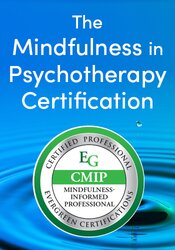Mindfulness & Psychotherapy: 5 Ways to Alleviate the Pain of Modern Craze

We live in the fast lane; such hecticness imprints on the body. Often in therapy, we find our clients confused and scared, prey to anxiety, and heart rates spiking for no apparent reason. Our clients are left confused and spiraling without a full awareness of how the body and the mind respond. However, mindfulness has undoubtedly made its way into mainstream America and into psychotherapy to address these kinds of situations. Mindfulness practices integrate with ease into talk therapy. Because mindfulness leads to somatic awareness, it can assist in dislodging stress from the nervous system and deal with trauma-related responses, such as dysregulated arousal, unsettling emotions, cognitive distortions, and incongruences.
Wait, but what is mindfulness?
Let’s put it as plainly as possible: Mindfulness is our capacity to develop a full awareness of what we do. It refers to moment-to-moment awareness of our emotions, sensations, thoughts, and other mental activities. It means we train our mind to do something it knows innately, to pay attention to the here-and-now moment, and to do it without judgment. We have a body that does many things without our command. Let’s say, for instance, we catch an infection, and without our knowledge, the body deploys white blood cells to attack the intruders, no questions asked. Most of the time, we don’t even know it’s happening; it is a distraction that works on our favor. When it comes to the mind and behaviors, both inner and external behaviors, the story is not quite so simple. Our mind is a spiderweb we get caught in often, which distract us from being aware of how we are interacting with ourselves and others. Fortunately, we can train the mind and do things fully aware of them. Activities such as walking, standing, doing dishes, talking, eating, drinking, reading, playing sports, doing yoga, and other physical activities are all opportunities to train in mindfulness.
So, mindfulness implies deliberately paying attention with a non-judgmental willingness. It means to appreciate both internal and external experiences and processes. We have an inner and external ecology; they complement each other and, therefore, need the conduit of mindfulness to complete themselves in the sense that they influence each other. A joyful mood spills over and irrigates the outer and inner realms of our presence. This is important for therapists, as this understanding gives us the parameters for creating co-regulation with our clients. Mindfulness reminds us we are in constant interaction with all that exists in our experiences.
Where does mindfulness come from?
Mindfulness originates in a discourse given by Sakyamuni Buddha after his enlightenment. This approach, mindfulness, is the common thread across all schools of Buddhism. In that discourse, the Buddha established four foundations that, when practiced regularly, can lead to inner freedom and the cessation of unnecessary suffering: mindfulness of having a body; mindfulness of feeling tones or Vedana, the three primaries being like, dislike, and neutral; mindfulness of thoughts; and lastly mindfulness of the dhamma.
Why are Buddha’s four foundations essential in the field of psychotherapy?
Through full awareness, a consequence of mindful attention, one can better become connected to where our thoughts, actions, feelings, and perceptions, or the mental formations that give birth to them are originating. That way, we can better calibrate where we stand and whether our actions and values align. In other words, the awareness produced by mindfulness helps us see whether our actions are coming from a beneficial or hindering source. When we identify the source of our beliefs, thoughts, sentiments, and actions, we can redirect them according to what serves best.
How can mindfulness help in therapy?
Paying attention to our breathing is a form of practicing mindfulness of the body. When we stop to examine if we like, dislike, or are neutral about something, we practice mindfulness of feeling tones or Vedana. When we notice the mind and thoughts without making each thought into a story, we practice mindfulness of thoughts. The simplest way to understand the fourth foundation, especially for non-monastic people like us, is that mindfulness of the Dhamma implies paying attention to all that is arising; it means paying attention to what is. For instance, we consider having a body with gross and subtle qualities. We might notice the posture in which we are seated or standing. We might then go to the feeling tones, like, dislike, or neutral, and then to the state of the mind right in the moment. The four foundations help us understand how we show up to every aspect of life and bring us a sense of cohesion or integration.
When mindfulness guides our behaviors, we frequently connect from and with awareness of our mental, emotional, and physical states. This awareness allows us to be more careful of our deliveries of words and gestures. That way, we can better free ourselves of reactivity, and useless habitual patterns. Inner behaviors include thinking, feeling, and emoting, and outer behaviors include showing anger, joy, and fear or taking actions such as walking, eating, sleeping, etc. Mindfulness makes us more aware of how, when, and why we do things. It facilitates our interactions with other beings, from humans, rivers, and mountains to pets.
Once mindfulness becomes part of our daily lives, we can see how it has the potential to generate balance, guide our choices, fine-tune our wisdom, and facilitate acceptance and willingness to do things differently and in congruence with our values.
How can we apply mindfulness to our clinical offerings?
1. Mindfulness can create a context for therapy sessions by establishing a sense of presence and connection to the present moment. It serves as a grounding force that brings us and those in our presence into a compassionate awareness of how we are showing up. It can be as simple as starting each session with a breathing practice to signal the transition into a creative, sacred time for understanding, healing, and connecting.
2. Mindfulness also keeps us connected to what matters, to what brought us into psychotherapy in the first place. In this sense, Roshi Joan Halifax has created a practice called G.R.A.C.E, a perfect conduit for us to ground ourselves, remember our commitment, connect, and expand the ratio of our inner and outer reaches. G.R.A.C.E spells out as follows:
- Gathering attention
- Recalling intention
- Attunement to self and other
- Considering the context to gain insight and discernment
- Engaging, enacting, and ending the interaction
3. Mindful movement facilitates tapping into body and mind to awaken awareness and more easily identify what we need to feel attuned to ourselves and others. Simply practicing such things as lifting our arms to the side, feeling the motion and weight, and doing it very slowly can bring us into a state of connection with mind and body. Or, saying something that for us is bothersome, and at the same time, lifting our arms up above the head, changes the impact of what we are saying on the nervous system.
4. Mindfulness meditation, in which we become aware of the fullness of our mind, trains us to recognize the nature of the mind, always thinking, and prepares us to redirect it better. The wisdom we can derive might lead to us being better able to act maturely and compassionately. Mindfulness meditation solidifies our awareness of how we are showing up to life.
5. Mindful writing externalizes one’s consciousness and ties together the inner and outer worlds. Mindfulness facilitates our processing of emotional struggles. By familiarizing ourselves with the pain we feel, rather than eluding it, writing mindfully opens an avenue for therapeutic intervention. By naming our pain, we learn how to live with it, meaning that when we know something, we can most easily transform or shift it. This writing leans on silence, introspection, and free expression of how our lived experiences resonate with our internal world. Also, it catches how the outside environment impacts inner experiences and vice versa. In other words, it is a kind of writing done to metabolize our innermost experiences.
The human mind is a running machine that tends to do many things at once. The Four Establishments of Mindfulness prepare us to bring the mind machine into a calmer pace. The discourse of the Buddha left nothing out, giving us clear ways to stop the running machine of the mind. We can use all our experiences as objects of practice. Try it!

Elevate your practice: Learn advanced mindfulness techniques from experts. Guide clients through grief, trauma, and addiction. Certification & bonuses included.

Mindful Writing is an expressive practice that focuses on the present moment and silence, introspection, discernment, and other contemplative means.





